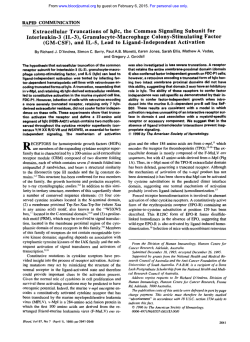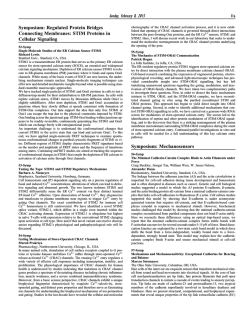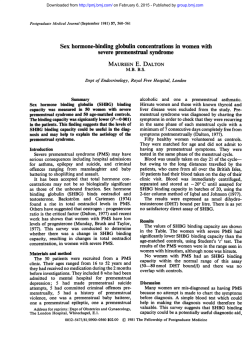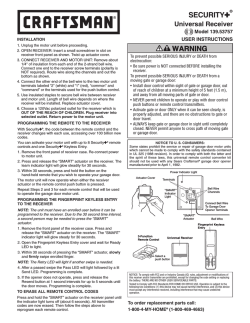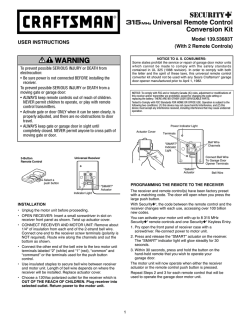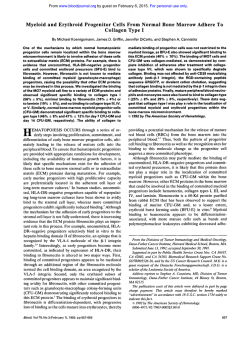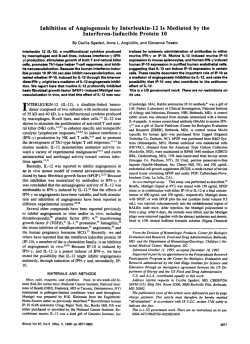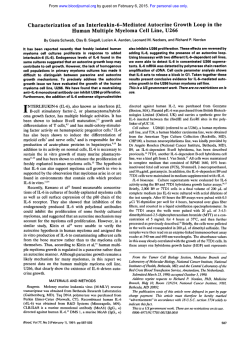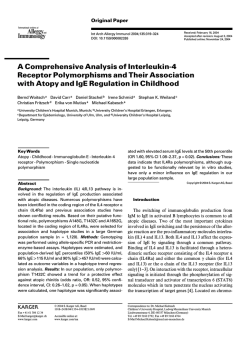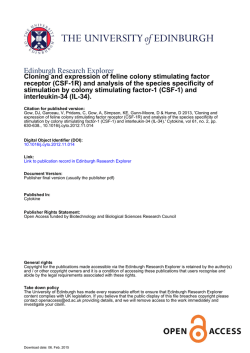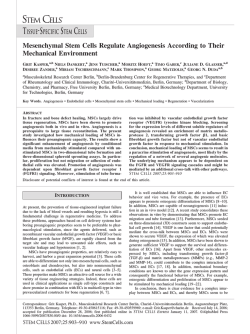
Endothelial Cells Express the Interleukin-1 Receptor Type I
Endothelial Cells Express the Interleukin-1 Receptor Type I By Diana Boraschi, Alessandro Rambaldi, Antonio Sica, Paolo Ghiara, Francesco Colotta, Ji Ming Wang, Marco de Rossi, Carla Zoia, Giuseppe Remuzzi, Federico Bussolino, Giuseppe Scapigliati, Antonella Stoppacciaro, Luigi Ruco, Aldo Tagliabue, and Alberto Mantovani Interleukin-1 (11-1) profoundly affects a number of functions of vascular cells. Two distinct IL-1 receptors (IL-IR) are expressed on different cell types: the 80 Kd IL-IR, on T cells and fibroblasts, and the 68 Kd IL-IR,, on B cells and myelomonocytic cells. The presence and functionality of IL-1R on vascular cells has been investigated by using polyomatransformed mouse endothelial cell (EC) lines (sEnd.1 and tEnd.1). These cells expressed specific and saturable binding sitesfor IL-I (1,273 sites per cell with kd 9.5 x lo-" mol/Lfor sEnd.1, and 771 sites per cell with kd 8.5 x lo-" mol/L for tEnd.1, with radioiodinated IL-la as ligand). Binding of IL-1 was also evident at single cell level by autoradiography. By cross-linking studies, the molecular weight of the IL-I binding protein on EC was approximately 80 Kd. This was confirmed by the presence in EC of mRNAfor the 80 Kd IL-IR,. The IL-lR, on EC was apparently functional, since EC responded to IL-1 with IL-6 mRNA expression and IL-6 bioactivity production. These results were extended to human EC and vascular smooth muscle cells, which were also found to express mRNAfor IL-lR,. 0 1991 by The American Society of Hematology. I marrow granulocytes.21 These cells do not express the IL-lR,. Little is known concerning the IL-lR present on EC. Thieme et al' characterized the binding of IL-la to human umbilical vein ECs. By immunoprecipitation and chemical cross-linking to the ligand they identified a 78 Kd IL-1binding protein on human EC.24 Here we report that vascular cells (mouse EC; human EC, and smooth muscle cells [SMC]) express the 80 Kd IL-lR,. NTERLEUKIN-1 polypeptides are prototypic pleiotropic cytokines whose action encompasses various organs and tissues.' Endothelial cells (EC) have emerged as one important target for IL-l.2s3IL-1 and the functionally related cytokine tumor necrosis factor (TNF) activate EC functions mainly related to inflammation and thrombosis. These include production of procoagulant activity: prostaglandins,5s6platelet-activating factor (PAF),' and plasminogen activator inhibitor'; inhibition of the synthesis of plasminogen activator* and alterations in the thrombomodulidprotein C anticoagulation pathway'; expression of adhesion molecules'o; and production of cytokines." The action of IL-1 on cells is mediated via specific receptors. An 80 Kd IL-1 binding protein (IL-1RJ has been purified from a murine thymoma cell line" and a cDNA that encodes this protein has been c10ned.l~This 80 Kd IL-1R is expressed in mouse and human T cells, fibroblasts, keratinocytes, and epithelial cell^.'^''^ Affinity cross-linking suggested that the IL-1R on B cells would be a 60 to 68 Kd pr~tein.",'~ Further evidence for the existence of a second distinct IL-1R (IL-lR,J has been provided recently.20-22 This receptor, identified using Epstein-Barr virus (EBV) transformed human B cell lines and the murine 702/3 pre-B cell line, is also expressed on mouse macrophages and bone From Sclavo Research Center, Siena; Istituto di Ricerche Farmacologiche Mario Negri; Milano and Bergamo; the Departments of Medical Genetics, Biology, and Ckmisby, University of Torino; the Department of Human Biopathology, University of Roma; and Domp2 S.p.A., Milano, Italy. Submitted January 28,1991; accepted May 3,1991. Supported by a fellowship of Consocio Mario Negri Sud, S. Maria Imbaro, Chieti, Italy. Also supported by Minister0 della SanitdIstituto Superiore della Sanita (National AIDS Project). The generous contribution of the Italian Association for Cancer Research is gratefully acknowledged. Address reprint requests to Alberto Mantovani, MD, Laboratoly of Immunology, Istituto di Ricerche Farmacologiche Mario Negri; via Eritrea 62, I-20157Milan0, Italy. The publication costs of this article were defrayed in part by page charge payment. This article must therefore be hereby marked "advertisement" in accordance with 18 U.S.C.section 1734 solely to indicate this fact. 0 1991 by TheAmerican Society of Hematologv. 0006-4971I9117805-0027$3.00/0 1262 MATERIALS AND METHODS Cells. The mouse endothelioma cell lines sEnd.1 and tEnd.1 were obtained through the courtesy of Dr E.F. Wagner (European Molecular Biology Laboratory, Heidelberg, FRG). These cell lines, derived from a subcutaneous (s) and thymic (t) hemangioma, express the polyoma middle T antigen, have cobblestone endothelial-like morphology, express von Willebrand factor, and cause hemangiomas in vivo.25**6 Expression of von Willebrand factor was checked during this study. The cells were maintained in Dulbecco's modified Eagle's medium (DMEM) containing 15% fetal bovine serum (FBS) and 750 pg/mL G418. Human ECs were isolated from umbilical veins and cultured in medium 199 (GIBCO, Paisley, Scotland) supplemented with 20% FBS in the presence of an EC cell growth supplement (50 @mL; Sigma Chemical Co, St Louis, MO) and porcine intestinal heparin (100 pg/mL; Sigma). EC were used within the eighth passage. Human vascular SMCs derived from the femoral artery were kindly donated by Dr G. Gabbiani (University of Geneva School of Medicine, Switzerland). SMC were cultured in DMEM containing 10% FBS. When cells were confluent, human recombinant IL-1p (Sclavo, Siena, Italy) was added at 10 ng/mL for 4 or 20 hours before extraction of mRNA. IL-lp had a specific activity of 1 X l@ U/p,g on D10.G4.1 cells when compared with the interim IL-lp reference reagent 86/552 (arbitrary titer 1 X l@Ulpg; NBSB, NIBSC, Potters Bar, South Mimms, UK) and was free of endotoxin ( I 0.08 pg LPS/p,g IL-1). Autoradiographic determination of IL-1 binding. Human recombinant IL-la, radioiodinated with the chloramine T method, was purchased from Du Pont-NEN (Boston, MA) and had a specific activity of 2.2 x lo6 dpdpmol. Endothelioma cells were grown to confluency on 8-chamber tissue culture chambedslides (Lab-Tek Division, Miles Laboratories, Naperville, IL). Washed monolayers were incubated with approximately 0.3 nmol/L '"I IL-la in 0.1 mL of DMEM with 15% FBS and 0.02% NaN, (binding medium) for 3 hours at room temperature with gentle agitation. At the end of the incubation, gaskets were removed, slides were extensively washed Blood, Vol78, No 5 (September l), 1991:pp 1262-1267 1263 IL-1 RECEPTOR IN ENDOTHELIUM by dipping in PBS and k e d for 30 seconds in acetone at room temperature. Slides were stored at -20°C until autoradiography. Slides were postfured for 1minute in cold acetone, then covered by dipping with NTB3 Kodak photographic emulsion. After 2 days of exposure, slides were developed with Kodak D19 developer and Rapid Fixer and counterstained with hematoxylin. Results were evaluated by the method of Schlessinger et al?’ The cut off for positivity of IG1 binding was calculated as the median number of silver grains on cells incubated with cold IG1 plus three times the standard deviation (SD), multiplied for a field factor (ie, the number of grains per field without cells in the slides incubated with labeled IL-lP divided by that in slides incubated with cold IL-lB). ZL-1binding assay. Replicate confluent monolayers of 1to 2 X 106 cells per well of Cluster6plates (Costar, Cambridge, MA) were incubated with increasing doses of ‘=I IL-1 in 0.5 mL of binding medium for 3 hours at room temperature under gentle agitation on a rocking platform. Nonspecific binding was assessed in the presence of a 500-fold molar excess of unlabeled IL-1. Wells were then extensively washed in PBS, monolayers were dissolved in 0.5 mL 9.5 m o m urea, and radioactivity was counted. Control monolayers were trypsinized for exact determination of cell numbers. Calculations and Scatchard analysis were performed according to Munson and Rodbard?’ Affinity cross-linking. ‘=I IL-la was cross-linked to intact cells with disuccinimidyl suberate (DSS) or with dithiobis (disuccinimidyl propionate) (DSP) (Pierce, Rockville, MD) as previously described.16 Briefly, cell monolayers (3.0 x lo7 cells) in binding medium were incubated with IL-la (0.5 nmoUL) for 3 hours at room temperature in gentle agitation with or without a 500-fold molar excess of unlabeled IL-1. After washing the unbound IL-1, DSS or DSP (50 mg/mL in DMSO) were added to a final concentration of 2 mg/mL, and the reaction was allowed to proceed for 45 minutes at room temperature with vigorous shaking, then centrifuged in Eppendorf for 5 minutes. The supernatant was denatured with Laemmli sample buffer?’ Sodium dodecyl sulfatepolyacrylamidegel electrophoresis (SDS-PAGE) was run on 10% gel using colored molecular weight markers (Amersham, Little Chalfont, UK). Dried gels were exposed at -40°C using Kodak XAR-5 autoradiographic film. Northern blot analysis. Northern blot analysis was performed according to standard procedures.30Total RNA was isolated from confluent cell cultures by guanidine isothiocyanate method.” In some instances, polyadenylated RNA was prepared by chromatography on oligo dT cellulose columns (Pharmacia, Uppsala, Sweden). Aliquots of 10 pg total RNA were analyzed by electrophoresis through 1% agarose formaldehyde gels followed by Northern blot transfer to Gene Screen Plus membrane (Du Pont-NEN). A human IL-1 receptor cDNA (HindIII-EcoRI fragment of 477 bp)” was obtained through the courtesy of Dr S.K.Dower (Immunex Corp, Seattle, WA). The mouse IL-1 receptor cDNA (SmaI fragment of 1,800 bp) was cloned in this laboratory by polymerase chain reaction according to the sequence cloned by Sims et al.” The mouse IL-6 cDNA probe (EcoRI-BglII fragment of 650 bp) was a kind gift of Dr J. Van Snick (Ludwig Institute, Bruxelles, Belgium). These fragments were labeled to a specific activity of lo9 cpm/pg by using hexanucleotide primers and a3*P-CTP.Membranes were pretreated and hybridized in 50% formamide (Merck, Rahaway, NJ) with 10% dextran sulfate (Sigma) and washed twice with 2x SSC (lx SSC: 0.15 moUL sodium chloride, 0.015 m o m sodium citrate) then twice with 2x SSC plus 1% SDS (Merck) at 60°C for 30 minutes and finally twice with 0 . 1 ~SSC at room temperature for 30 minutes. The membranes were exposed for 12 to 24 hours at -80°C with intensifying screens. RNA loading and transfer to membrane was checked by examination under UV light and hybridization of the blot with an a-actin probe. ZL-6bioactiviry assay. IL-6 was measured as hybridoma growth factor (HGF) activity using the 7TD1 cell line, obtained through the courtesy of Dr J. Van Snick. Briefly, 2 x 10’ cells in 200 pL (four replicates per experimental point) were cultured for 72 hours with different dilutions of the supernatants to be tested or of the appropriate control medium. Routinely, cell proliferation was assessed by the (3-4,5-dimethylthiazol-2-yl)-2,5-diphenyl-tetrazolium bromide colorimetrictest as described.” Alternatively, cells were pulsed with 0.5 kCi/well [’HI dThd (sp act 185 GBq/mmol; Amersham) for 6 hours. HGF activity resulting in half maximal stimulation of target cell growth was arbitrarily defined as 1 U. Reference standards used in these experimentsconsisted of human recombinant IG6 or IL-brich supernatant of a mixed lymphocyte reaction. RESULTS AND DISCUSSION Vascular cells are one important target for IL-1. On interaction with IL-1, ECs undergo a complex reprogramming of function, which favors thrombosis, leukocyte recruitment, and inflammation? A limitation to the detailed analysis of modulation of EC functions has been the unavailability of continuous EC lines. Recently, murine endothelioma cells lines have been established from hemangiomas developed in mice on infection with a retroviral vector carrying the polyoma virus middle T oncogene.”.26 These lines have endothelial morphology and express EC markers,” and might thus be suitable for study of E C modulation in vitro, if they also maintain EC functional characteristics. In order to evaluate the ability of polyomatransformed cells to respond to IL-1 modulation, two of these lines, sEnd.1 and tEnd.1, have been analyzed for expression of IL-lR and functional response to IL-1 stimulation. We focused on mouse EC initially because most available information concerning the existence of differential distribution of distinct IL-1R has been obtained in the Specific binding of radioiodinated IL-1 to sEnd.1 cells was first evaluated at the single cell level by autoradiography on cells cultured on glass slides. As shown in Fig 1, sEnd.1 cells could efficiently bind radioiodinated IGla. Binding capacity was, however, not homogeneous, with approximately 30% of cells showing significant binding of IL-la (8% had > 100 grains per cell; 9% between 50 and 100 grains per cell; and 13% between 30 and 50 grains per cell), and the other 70% showing only few associated silver grains ( < 30 per cell). Cells showing the highest density of associated grains were highly adherent and with a large cytoplasm (Fig 1). These data indicate that endothelioma cells possess receptors for IL-1. Two structurally distinct IL-1R have been identified, with differential cellular d i s t r i b ~ t i o n . ’ ~Only ~ ~ *the ~ ~ 80 Kd ILlR,, expressed on T cells and fibroblasts, has been molecularly cloned and ~equenced.’~’~ A second type of IL-1R has been found on B cells and on myelomonocytic cell^.'^-^^^ The IL-lR,, has a molecular weight of approximately 68 Kd and, at variance with IL-lR,, apparently binds IL-1p more abundantly than IL-hZO>’The role of the two types of IL-lR in the mechanisms of cellular activation by IL-1 is 1264 BORASCHI ET AL Fig 1. Binding of IL-1 to murine endothelioma cells. Monolayersof sEnd.1 cells on glass slides were incubated with '"I IL-lufor 3 hoursthen examined for IL-1 binding by autoradiography. Original magnification: x 100 (A), x500 (e). not clear. Presumably, the two IL-1R types are coupled to distinct intracellular signal transduction pathways" and are associated with different rates of ligand internalization and intracellular degradati~n?~ The characteristics of the IL-1R present on endothelioma lines have been assessed by binding studies. As shown in Fig 2 (A,B), the two endothelioma lines tEnd.1 and sEnd.1 showed specific and saturable binding of radioiodinated human recombinant IL-la. The number of IL-1 binding sites per cell and the affinity of binding were similar between the two lines (1,273 sites per cell with kd 9.5 X lo-" mol/L for sEnd.1, and 771 sites per cell with kd 8.5 X lo-'' mol/L for tEnd.1, respectively). IL-1 receptors on human EC showed similar characteristics (ref. 23 and 35; 2 experiments not shown), with a somewhat lower number of binding sites (100 to 500 sites per cell). By chemical cross-linking of radiolabeled IL-la to sEnd.1 membrane proteins with DSS, a single cross-linking product could be seen, of molecular weight of approximately 98 Kd (Fig 2, C). Accordingly, the presence of a 98 Kd product was evident also when DSP was used as a cross-linking agent (data not shown). By subtracting the molecular weight of bound IL-la (17.5 Kd), this corresponded to an IL-1 binding protein of approximately 80 Kd. This is in agreement with the molecular weight of the IL-lR described on human EC (ie, 78 Kd)" and suggests that the IL-1R expressed by EC is the IL-lR,. To clarify this point, the expression of mRNA encoding the IL-lR, has been examined. As shown in Fig 3, both sEnd.1 and tEnd.1 had appreciable levels of IL-lR, transcripts, though these were substantially lower than those detected in 3T3 murine fibroblasts used as positive controls (these express over 5,000 IL-lR per cell).21s36 Having established that the mouse endothelial lines express IL-lR,, it was important to evaluate whether these cells indeed respond to IL-1 stimulation, ie, whether their IL-1R was functional. As shown in Fig 4,IL-1 was able to induce high levels of IL-6 mRNA in both the sEnd.1 and the tEnd.1 lines. In parallel to detection of message transcription for IL-6, an increase of IL-6 biologic activity could be detected in the culture supernatant. In fact, IL-1-stimulated sEnd.1 and tEnd.1 cells produced 568 U/mL and 1,250 U/mL of IL-6, respectively, whereas only 82 U/mL and 83 U/mL of IL-6 bioactivity could be detected 11-1 RECEPTOR IN ENDOTHELIUM 1265 s End. 1 t End. 1 1,273 sites/cell Kd = 95 pM 0 0.05 0.10 0.15 / /p Bound 771 sites/cell Kd = 85 pM "." CROSS-LINKING 0.20 0 0.05 0.10 0.15 Cold IL-1 0.20 Free pmoledwell Fig 2. Equilibrium binding and cross-linking of "1 IL-lat o murine endothelioma cells. For equilibrium binding analysis, specific binding of increasing amounts of 161 IL-la (free) was determined in the presence of 500-fold molar excess of unlabeled IL-1. Scatchard analyses are reported in the insets: B, bound; F, free; in abscissa are bound fmol/well. (A) tEnd.1 cells. (B) sEnd.1 cells. (D) Cross-linking of '=I IL-la on sEnd.1 cells, performed with DSS in the absence (-) or in the presence (+) of unlabeled IL-1. in the absence of IL-1. The ability of IL-1 to induce IL-6 synthesis in murine endothelioma cells is in full agreement with previous observations in human EC." It is of interest that the recently identified IL-1 receptor antagonist, reportedly interacting with type I receptors, inhibits the action of IL-1 on human and murine endothelium (data not shown)?' Thus, murine endothelioma cell lines sEnd.1 and tEnd.1 express functional IL-lR, similar to that observed on human EC. However, that the IL-lR present on human 1 2 3 vascular cells is in fact the IL-lR, was inferred only by the size of the IL-1 binding protein observed in cross-linking studies, ie, approximately 78 Kd.24To ascertain that human vascular cells possess the IL-lR,, we have examined human 1 2 3 4 5 6 7 .. - 285 - 185 - 185 Fig 3. IL-lR, expression in murine endothelioma cells. Lane 1, positive control (10 p g of total RNA from 3T3 murine fibroblasts); lane 2, sEnd.1 cells (5 p g poly A+ RNA); lane 3, tEnd.1 cells (2 p g poly A+ RNA). Fig 4. Kinetics of IL-6 mRNA expression induced by IL-lp in murine endothelioma cells. sEnd.1 cells (lanes 1,3,5) and tEnd.1 cells (lanes 2, 4, 6) were either left untreated (lanes 1 and 2) or incubated with 10 ng/mL of human recombinant 11-1p f o r 4 hours (lanes 3 and 4) or for 20 hours (lanes 5 and 6). Murine N11 microglioma cells" were used as positive control (lane 7). On each lane, 10 p g of total RNA were loaded. BORASCHI ET AL 1266 SMC EC 1 2 I -- IL-lR 285 :., . .._, ,.. EC and SMC for IL-lR, mRNA expression. As shown in Fig 5, both EC and SMC express mRNA for IL-lR,. Exposure of human vascular cells, as well as murine endothelioma cells, to IG1 did not appreciably affect IL-lR, mRNA expression (Fig 5, data not shown). The results reported here demonstrate that murine EC and human EC and SMC express IL-lR,, though they do Fig 5. IL-lR, expression in human vascular cells. (Left) HumanEC. (Right) HumanSMC, preincubated 4 hourswithout (lane 1) or with 10 ng/mL IL-1p (lane 2). On each lane, 10 pg of total RNA were loaded. not formally exclude that these cells may at the same time have other IL-1R types on their membrane. The availability of the recently cloned soluble form of IL-lR:9 and that of a neutralizing monoclonal antibodies for the murine IL-lR,Z' will help to finely evaluate in vitro and in vivo the precise role of IL-1 in vascular cell activation in pathologic conditions. REFERENCES Damme J, Dejana E, Mantovani A IL-1 stimulates IL-6 produc1. Dinarello C A Interleukin-1 and its biologically related cytotion in endothelial cells. J Immunol142549,1989 kines. Adv Immunol 44:153,1989 12. Urdal DL, Call SM, Jackson JL, Dower S K Affinity purifica2. Pober JS: Qtokine-mediated activation of vascular endothetion and chemical analysis of the interleukin-1 receptor. J Biol lium. Physiology and pathology. Am J Pathol133:426,1988 Chem 263:2870,1988 3. Mantovani A, Dejana E: Cytokines as communication signals 13. Sims JE, March CJ, Cosman D, Widmer MB, Mac Donald between leukocytes and endothelial cells. Immunol Today 10370, HR, Mc Mahan CJ, Grubin CE, Wignall JM, Jackson JL, Call SM, 1989 Friend D, Alpert AR, Gillis S, Urdal DL, Dower SK cDNA 4. Bevilacqua MP, Pober JS, Majeau GR, Cotran RS, Gimbrone expression cloning of the IL-1 receptor, a member of the immunoMA Jr: Interleukin-1 (IL-1) induces biosynthesis and cell surface globulin superfamily. Science 241:585,1988 expression of procoagulant activity in human vascular endothelial 14. Chua AO, Gubler U: Sequence of the cDNA for the human cells. J Exp Med 160:618,1984 fibroblast type interleukin-1 receptor. Nucleic Acids Res 17:10114, 5. Dejana E, Breviario F, Erroi A, Bussolino F, Mussoni L, 1989 Gramse M, Pintucci G, Casali B, Dinarello CA, Van Damme J, 15. Sims JE, Acres RB, Grubin CE, Mc Mahan CJ, Wignall JM, Mantovani A Modulation of endothelial cell functions by different March CJ, Dower SK: Cloning the interleukin-1 receptor from molecular species of interleukin 1. Blood 69:695,1987 human T cells. Proc Natl Acad Sci USA 8623946,1989 6. Rossi V, Breviario F, Ghezzi P, Dejana E, Mantovani A 16. Chin J, Cameron PM, Rupp E, Schmidt J A Identificationof Prostacyclin synthesis induced in vascular cells by interleukin-1. a high affinity receptor for native human interleukin 1p and Science 229:174,1985 interleukin la on normal human lung fibroblasts. J Exp Med 7. Bussolino F, Breviario F, Tetta C, Aglietta M, Mantovani A, 165:70,1987 Dejana E Interleukin-1stimulatesplatelet-activatingfactor produc17. Kupper TS, Lee F, Birchall N, Clark S , Dower S: Interleution in cultured human endothelial cells. J Clin Invest 77:2027, kin-1 binds to specific receptors on human keratinocytes and 1986 induces granulocyte macrophage colony-stimulatingfactor mRNA 8. Schleef RS, Bevilacqua MP, Sawdey M, Gimbrone MA Jr, and protein. J Clin Invest 82:1787,1988 Loskutoff DJ: Cytokine activation of vascular endothelium. Effects 18. Matsushima K, Akahoshi T, Yamada M, Furutani Y, Oppenon tissue-type plasminogen activator and type 1 plasminogen heim JJ: Properties of a specific interleukin-1 (IL-1) receptor on activator inhibitor. J Biol Chem 263:5797,1988 human Epstein Barr virus-transformed B lymphocytes: Identity of 9. Nawroth PP, Handley CT,Esmon C, Stem D M Interleukin-1 the receptor for IL-1-a and IL-1-p. J Immunol136:4496,1986 induced endothelial cell procoagulant while suppressing cell19. Horuk R, Huang JJ, Covington M, Newton R C A biochemisurface anticoagulant activity. Proc Natl Acad Sci USA 83:3460, cal and kinetic analysis of the interleukin-1 receptor. Evidence for 1986 differences in molecular properties of IL-1 receptors. J Biol Chem 10. Carlos TM, Harlan JM: Membrane proteins involved in 26216275,1987 phagocyte adherence to endothelium. Immunol Rev 114:5,1990 20. Scapigliati G, Ghiara P, Bartalini M, Tagliabue A, Boraschi 11. Sironi M, Breviario F, Proserpio P, Biondi A, Vecchi A, Van IL-1 RECEPTOR IN ENDOTHELIUM D: Differential binding of IL-la and IL-lP to receptors on B and T cells. FEBS Lett 243:394,1989 21. Chizzonite R, Truitt T, Kilian PL, Stern AS, Nunes P, Parker KP, K&a KL, Chua AO, Lugg DK, Gubler U: Two high-affinity interleukin-1 receptors represent separate gene products. Proc Natl Acad Sci USA 86:8029,1989 22. Bomsztyk K, Sims JE, Stanton TH, Slack J, Mc Maban CY, Valentine MA, Dower S K Evidence for different interleukin-1 receptors in murine B- and T-cell lines. Proc Natl Acad Sci USA 86:8034,1989 23. Thieme TR, Hefeneider SH, Wagner CR, Burger DR: Recombinant murine and human IL-la bind to human endothelial cells with an equal affinity, but have an unequal ability to induce endothelial cell adherence of lymphocytes. J Immunol 139:1173, 1987 24. Thieme TR, Wagner CR: The molecular weight of the endothelial cell IL-1 receptor is 78,000. Mol Immunol26:249,1989 25. Williams RL, Courtneidge SA, Wagner E F Embryonic lethalities and endothelial tumors in chimeric mice expressing polyoma virus middle T oncogene. Cell 52121,1988 26. Williams RL, Risau W, Zerwes H-G, Drexler H, Aguzzi A, Wagner EF: Endothelioma cells expressing the polyoma middle T oncogene induce hemangiomas by host cell recruitment. Cell 57:1053,1989 27. Schlessinger J, Schechter Y, Willingham MC, Pastan I: Direct visualization of binding, aggregation, and internalization of insulin and epidermal growth factor on living fibroblastic cells. Proc Natl Acad Sci USA 752659,1978 28. Munson PJ, Rodbard D: LIGAND: A versatile computerized approach for characterization of ligand-bindingsystems. Anal Biochem 107:220,1980 29. Laemmli U K Cleavage of structural protein during assembly of the head of bacteriophage T4. Nature 227680,1970 1267 30. Sambrook J, Fritsch EF, Maniatis T Molecular Cloning, 2nd ed. Cold Spring Harbor, NY,Cold SpringHarbor Laboratory, 1989 31. Chirgwin JM, Przybyla AE, Mac Donald RJ, Rutter WJ: Isolation of biologically active ribonucleic acid from sources enriched in ribonuclease. Biochemistry 185294,1979 32. Ghiara P, ScapigliatiG, Tagliabue A, Boraschi D: Characterization of receptors for IL-la and IL-la on lymphoid and non lymphoid cells. J Immunol Res 1:13, 1989 33. Dinarello CA, Clark BD, Puren AJ, Savage N, Rosoff PM: The interleukin-1 receptor. Immunol Today 10:49,1989 34. Horuk R: Cellular binding, internalization and intracellular processing of interleukin-1, in Melli M, Parente L (eds): Cytokines and Lipocortins in Inflammation and Differentiation. New York, NY,Wiley-Liss, 1990, p 836 35. Cozzolino F, Torcia M, Aldinucci D, Ziche M, Almerigogna F, Bani D, Stern DM: Interleukin-1 is an autocrine regulator of human endothelial cell growth. Proc Natl Acad Sci USA 87:6487, 1990 36. Dower SK, Urdal D L The interleukin-1 receptor. Immunol Today 8:46,1987 37. Righi M, Mori L, De Libero G, Sironi M, Biondi A, Mantovani A, Donini SD, Ricciardi-CastagnoliP: Monokine production by microglial cell clones. Eur J Immunol19:1443,1989 38. Carter DB, Deiber MR, Dumm CJ,Tomich CS, Heinrikson RL, Truesdell SE, Shelly JA, Eessalu TE, Taylor BM, Tracey BM: Purification, cloning, expression and biological characterization of an interleukin-1 receptor antagonist protein. Nature 344:633,1990 39. Dower SK, Wignall JM, Schooley K, Mc Mahan CJ,Jackson JL, Prickett KS, Lupton S, Cosman D, Sims JE: Retention of ligand binding activity by the extracellular domain of the IL-1 receptor. J Immunoll424314,1989
© Copyright 2025
